This last tour we did was killer… I mean it killed a lot of stuff. Not only were the stages littered with the bodies of the slain, but the gear suffered horribly, too. We did six weeks with GWAR just before and had nary a hiccup. The following excursion was three weeks of headlining buffoonery that really did us in. iPods were lost, speakers blown, casters shot, cords frayed, pedals shorted, and antennas snapped. The two most tragic losses were amplifiers. Without an amp, a metal band you are not. Tenacious D be damned (funny, I find them not). Sean’s Peavey XXX took a hit and still remains defunct. My Ampeg V-4B, with a bit of tuning up on my own workbench, will live again!
When I last plugged in this disheveled beast, it was at Philadelphia’s Kung-Fu Necktie. Occultist had just finished a rousing set. I turned on my amp and it winked at me. The power light went on and then off. This was not good. A quick check of the external fuse revealed it had not blown. I couldn’t fathom what was wrong, but when I borrowed an amp, I found that I had a blown speaker in my 2×15. How and when I did not know. My amp, however, was expecting a 4Ω load and instead got 8Ω. Pop.
My first attempt to fix the V-4Beast was in Richmond, VA at a bar called Strange Matter. It must’ve been 120° in the back kitchen as I pulled it apart. The Ampeg V-4B has an internal fuse in addition to the external fuse. It’s a quick-blow 10A that is supposed to take care of any sudden power spikes that get past the external 6A fuse. It had blown.
I spent way to long, sans flux, getting that fucker soldered in. Yes, soldered. There is no fuse holder for it. Did the original designers forget to add this cartridge fuse until the amplifier was already being manufactured? Probably. It was a pain in the ass as solder just didn’t wanna stick to the end caps.
I hoped that would be it. I plugged in the amp that night, and… nothing. There was a slight buzz, no light, and then gone. Shit, this was officially out of my depth. I’d hoped to take it to a tech in Austin during our stay there for Chaos in Tejas, but there wasn’t time. For the rest of the tour, I borrowed Phil of Toxic Holocaust’s amp. I was thankful, but no offense to his little juggernaut, it wasn’t mine. So, booooooo!
Now at home, I finally found time to look up the problem. Luckily for me, there’s a dedicated website and forum to the Ampeg V-4 series of amps. This is an amp that has been discontinued for more than 30 years. It’s a very dedicated, slavish, and knowledgable little gathering of obsessed minds. One of the brightest ones at www.ampegv4.com suggested I check the flyback diodes. The whaaaaaaaat?
Here we are again with some strung together electronics crap living OFF the circuit board. Did they forget these, too? Apparently, it’s confirmed they did. Early V-4 amps don’t have this little safety nuance.
Flyback diodes protect, um… I’m not really sure. The output transformer? I’m pretty sure that’s it. If everything is working correctly, these do nothing. If power surges the wrong direction, like say, if you have a catastrophic and sudden Ω mismatch, these are supposed to dissipate the voltage and protect the transformer. Or sometimes, they fucking die. At that point, they just blow fuses. Difficult, horribly difficult to install fuses.
That genius on www.ampegv4.com nailed the symptom. Apparently, these little flyback doohickeys fail on a regular basis. He suggested I disconnect the diodes and then fire the amp back up. I did just that, and what the fuck! My amp breathed and lived! It’s alive, ALIVE!
So those little bastards were the problem I had. They also might have been a savior.
There’s a bit of a disagreement on the need for flyback diodes. Some think they’re like the appendix organ of the amp, useless and to be removed before it causes infection. Others think it’s better they maybe fail and add an extra layer of protection for the output transformer. The best metaphor I read was that it’s like a family that never gets attacked by a tiger and has a stone outside their house. The stone might be making them safe. Might not, but why move the stone? Or better yet, it’s like another terror attack not happening because of George W. Bush. The draconian police state he got rolling might have kept us safe from another terror attack after 9-11… or maybe Al Qaeda is actually kind of incompetent and just got lucky that other time.
Well, I decided to err on the side of protection and replace the flyback diodes. No problem, right? Wrong. This is some old shit. It ain’t easy being cheesy, and it ain’t easy finding these old parts. I had to source new parts. Again, the folks over at www.ampegv4.com came to the rescue and told me exactly what I would need to match the forward voltage of the original diodes: a pair of three 1N4007 flyback diodes wired in series.
The grey band indicates the cathode side of the diode. To wire these correctly, they must all be wired going the same direction. Voltage only flows one way through a diode. When the pair of strings are wired back in to the V-4, they should have the anode towards the terminal strip and the cathode towards the circuit board. They connect with the wires from the output transformer on solder pads near R45 and R46.
Voila! Everything is as it should be. Except that pesky soldered-in fuse. I wasn’t into that. For want of an inexpensive part, the Ampeg company cheaped out in the original design. I wasn’t gonna have it. Instead, I decided to wire in my own fuse holder for the 10A internal cartridge fuse.
Now my Ampeg V-4B is ready to blast thrash again. All it took was a few parts that cost under five bucks. Well, those cheap parts and the generous help of some wonderful online folk.

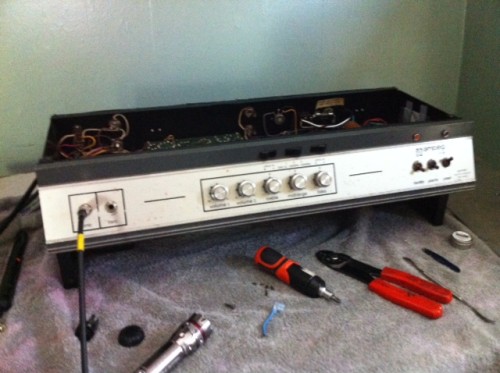
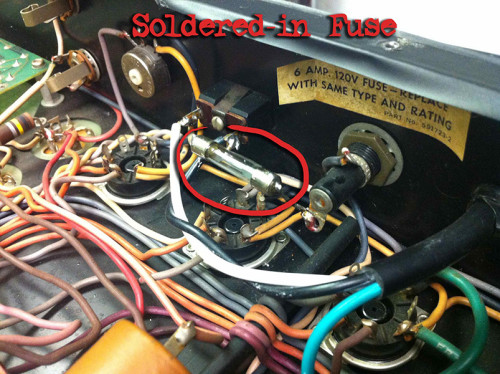
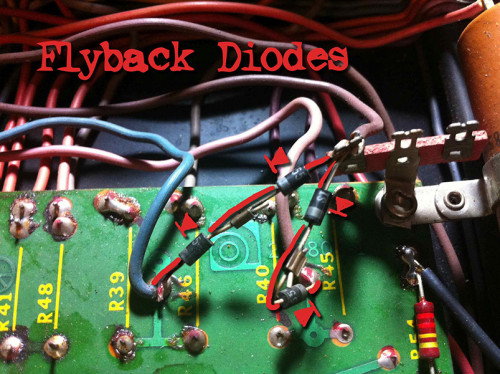
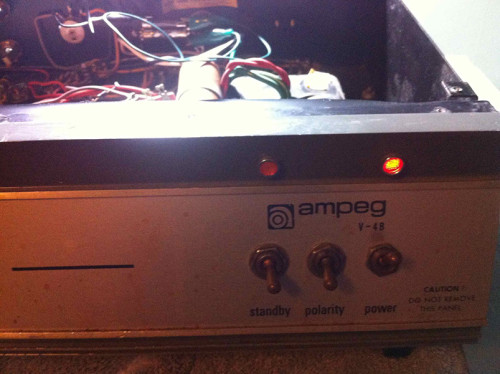
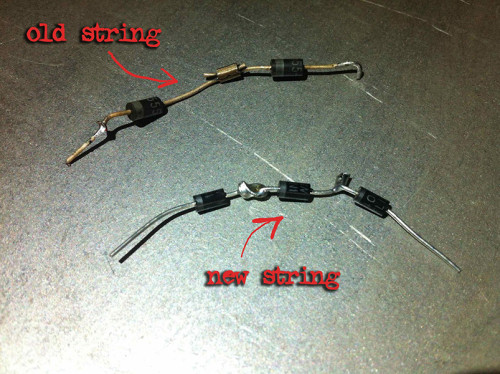
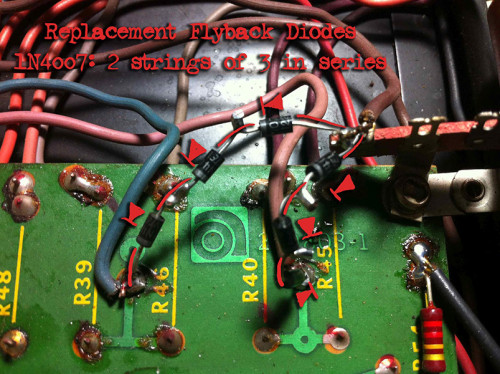
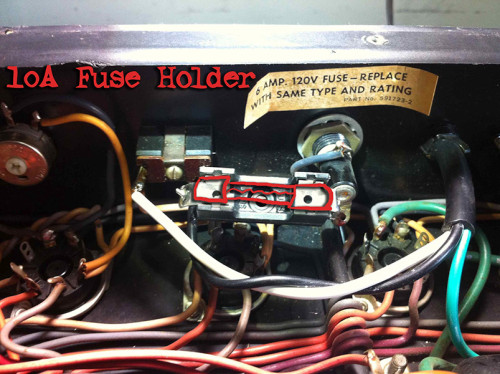
Well done!
But if you think replacing a few diodes is a pain, try replacing an output transformer in a thirty-year-old amp. A dead output transformer is often the end of the line for an old amp, so the diodes are a good idea.
Why is there a 10 amp fuse soldered inside in series with the externally accessible 6 amp fuse? This is simply because a common response to a blown 6 amp fuse is to replace it with whatever will fit – 25 amp headlight fuse from the car, brass screw; you name it, if it conducts electricity I've found it in a fuse holder.
And folk don't think of a fuse being like a boiler safety valve blowing off, or that putting a brass screw in there is like clamping the safety valve down, and the next thing you know there are flames and smoke coming out the back of the amp and it's going to need one hell of a lot more than a few crummy diodes.
And why is it soldered and no holder? Well the few times it is going to need replacing in the lifetime of the amp the connector is actually going to be less reliable than the 10 amp fuse, but they also want the amp to get into the hands of somebody with a soldering iron who hopefully has some idea of what they are doing, before a freaked-out musician reduces his amp to a smoking ruin on stage.
Anyway, like I say, well done! And with the Peavey too.
As for solder not sticking to the end-caps, you can buy fuses with pre-attached pigtails for just this purpose. They are much easier to solder in.
Such as: http://www.mouser.com/ProductDetail/Schurter/00011014PT/?qs=%2fha2pyFadugloyD57zvXzCXMTM4NLii04nlEyxDjxP0ih7FM%252bi3xog%3d%3d
Also, the tiger/stone analogy is a bit of a stretch. There's no plausible reason why a stone would keep a tiger away from the house, but there's a very good reason why the diodes work. By preventing one side of the OT from going negative, they prevent the other side from going too positive (which would burn up OT windings and/or tubes). The designers didn't so much forget the diodes as they underestimated the capacity of musicians to do stupid stuff like crank the amp with no speaker attached (which would cause the wild voltage swings these diodes defend against).
lovely, but not readily available to me at the time I fixed this. A simple flux pen made it easy, I'm sure a few of these pigtailed fused would've made it even easier.
As a stupid musician, I opted to keep the diodes in. So you know where I stand ultimately on the metaphor… I bash the tiger's head in with the stone to keep my life signs from going negative.